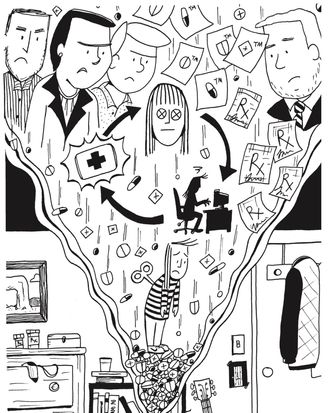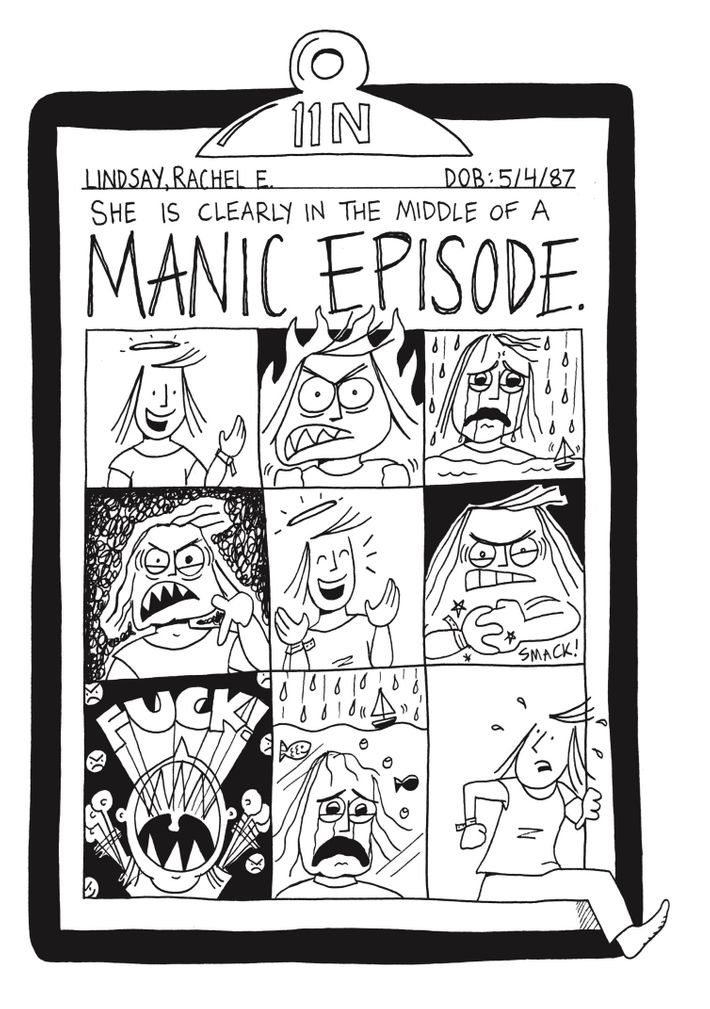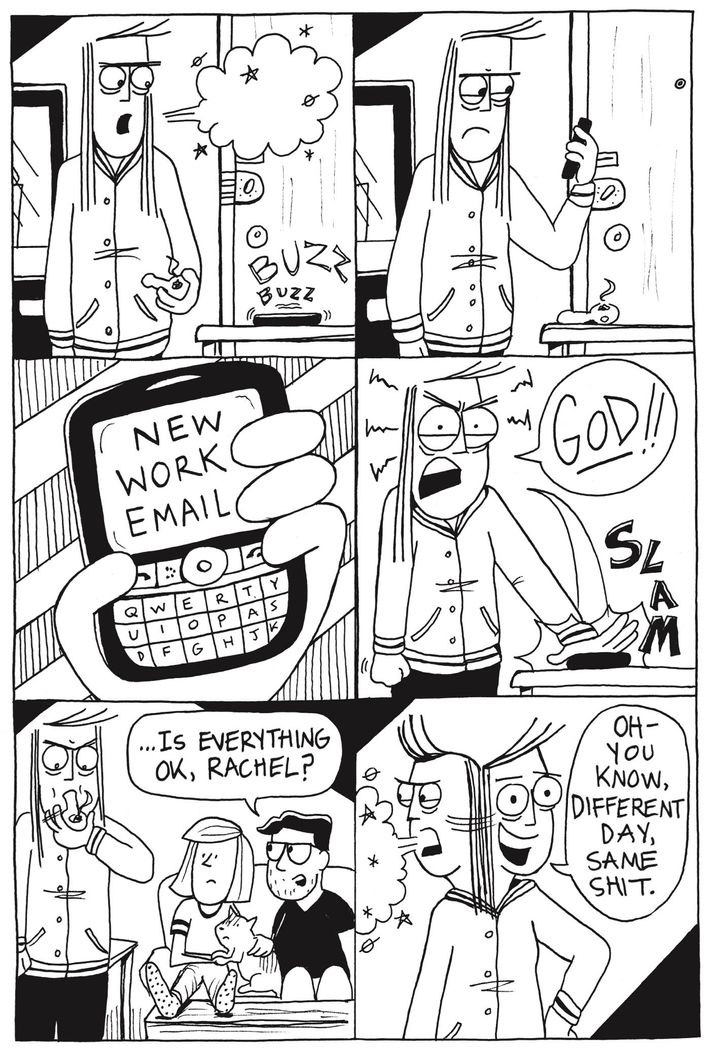
“You won’t know the shape of your own unraveling until it happens.”
So speaks the inked avatar of Rachel Lindsay a few pages into her debut graphic memoir, Rx. She sits with her legs spread and her arms in her lap, gazing toward the reader with baggy eyes from the cold comfort of a hospital bed. A tagged medical bracelet adorns her wrist. She is slipshod and her hair wisps off uncontrollably. It’s a deceptively crude drawing, comprised mostly of straight lines and blank textures. But one gets the feeling that this drawn human’s saucer eyes, so clear and simple, are cutting past whatever defenses you may have and channeling the words above her directly into your heart. Maybe I shouldn’t use the second-person in that statement. Your mileage may vary, but in that single-panel page, Lindsay was gripping me on a very individual level.
I, too, have never known the shapes of my own unravelings until they happen. Like Lindsay, I live with bipolar disorder. Like her, I have seen professionals and taken medications to treat that disorder for much of my life. And like her, I have learned that those practices are not cures. I, too, have been hospitalized during a manic episode and have come close to return engagements on a number of occasions. The phenomenon of mental decay is presented in such a blazingly clear and coherent way in Lindsay’s book that I can’t get it out of my head. For anyone with an affection for comics and an interest in ailments of the mind, Rx is required reading.
We live in an age when destigmatization of mental illness is allegedly a cultural priority, but there are realms that remain stupidly off-limits. We express tender affection for the depressive person, bludgeoned by misery and unable to move. We embrace the anxious one, held back from full participation in society due to the overwhelming tidal wave that is a panic attack. These are welcome developments. But, by and large, we have yet to confront the assholes.
That’s where we get to the shapes of unravelings. There are times when a bipolar patient loses their mind through sadness, melting into the bed and wishing for oblivion. But noble depression’s evil twin is mania, and as anyone who has lived through a manic episode can tell you, it makes bad ideas seem like exceedingly good ones. As such, it often leads you to hurt those around you with your selfish and impulsive acts. The trouble here is that we want to believe that everyone should be held accountable for their actions and we want to be sensitive to the distortions of mental illness — but what if those impulses are at cross-purposes? How should we navigate responsibility and forgiveness?
Rx doesn’t offer answers to those questions, but it deserves praise for the way it subtly asks them. From a 30,000-foot view, the narrative arc is familiar: person seems fine, person goes crazy, person confronts craziness, person comes out the other end with a new self-understanding. But the specific contours of Lindsay’s memoir surprise us with their idiosyncrasy.
She begins as an employee of a marketing firm, assigned to a Pfizer account that requires her to sell antidepressants. The gig triggers fury against the pharmaceutical industry that quickly reveals itself to actually be fury against the fact that she has to be a prisoner of her own drugs. She wants to move to the frontier, live as an artist and musician, figure herself out. But ever since she was diagnosed, her life has revolved around the goal of, as she puts it in a full-page panel of her flat-expressioned face, “Staying Sane™.” That means paying for medication and therapy via health insurance, and thus full-time employment. “Choices were made for me,” she writes above a silhouette of herself receiving a prescription from a doctor; flip the page and there’s a two-page spread of a hand holding two and a half pills, which speak the cursive words, “good night.”
Just her luck, a manic episode appears in which her ‚Äúmind puddle-jumped planets.‚Äù We see demi-circles appear under her eyes and inwardly slanted eyebrows above them. Her appetite for food decreases, her appetite for marijuana (a substance that she never really gets into but is clearly a problem for her, as it is for countless bipolar people) increases. ‚ÄúIt was all familiar,‚Äù she says. ‚ÄúI recognized the red flags. But in the context of the moment ‚Äî¬Ýit all felt like a completely reasonable reaction to my life.‚Äù Again, elegance should not be mistaken for simplicity here. Lindsay is making an astoundingly astute observation about mania, which is that it‚Äôs often rooted in understandable responses to the world. And, more important, it‚Äôs largely beyond your control once it rolls into effect, no matter how noticeable it might be.
I won’t spoil too much about how the episode plays out, but given the framing device of the story, it’s not a spoiler to say it leads her to a medical institution and a hard examination of truths she’s been avoiding. The book is a product of those examinations, and the moments that stuck with me most are the ones in which she recalls alienating those around her. She slacks off at work due to overconfidence about a possible new job and forces others to cover for her; she screams at her parents for pointing out the obvious-even-to-her fact that she’s manic; she tries to become — as she puts it in a chapter-heading image of herself in shades on a mean street — an “urban badass — talks mad smack, smokes dank bud, don’t give a fuck.” In the book’s hindsight, she can observe that “mania is a specific breed of insanity — calculated, omniscient, unyielding.” It strips you of remorse and responsibility. It’s a prick, and it can turn you into one.
Again, we get back to the shapes of unravelings. Mine haven’t looked exactly like Lindsay’s, but every day, I carry the regret of the awful romantic mistakes, arrogant professional decisions, self-destructive indulgences, and irreversible life choices I have made while manic. I, too, grapple with substance abuse and have turned to THC as a balm despite the fact that my psychiatrist told me it was only further breaking my brain. My specifics may differ, but I couldn’t get enough of Lindsay’s zoomed-out observations about the terrifying heights of our shared disorder. She does not paint herself as a hero, nor can I — we must bear the burdens of the stupid slip-ups we’ve made. Because who else will? She is merely asking for a shred of empathy from the people wronged by people like us.
She’s also trying to prove that comics can be a uniquely well-primed medium for narratives of mental illness. I spoke with Lindsay about the book and, time and again, she emphasized that notion. “Having the ability to show, versus tell, is really powerful,” she said. “But also, just being able to depict yourself as a cartoon character. My style is very old-school and cutesy, and I think that gives people a little bit of something to empathize with and to see that character through the whole experience by getting an emotional attachment.”
She’s onto something — as comics analyst Scott McCloud famously observed in Understanding Comics, simple faces can be easier to relate to than more detailed ones due to the primal fact that we perceive our own faces in simple terms when we’re not looking in a mirror. We see ourselves as smiley or frowny faces, and a blunt style like Lindsay’s allows us to subconsciously envision ourselves inside her emotions. That bluntness and seeming crudity also ensures that the reader isn’t distracted by flashy shows of detail and rendering. You are taking in the story and the feelings, undiluted by anything else
What’s more, there’s the matter of pacing. A prose novel moves the reader along the page at a consistent rate, whereas a comic can force you to slow down or speed up depending on the number and complexity of panels on a page. “Being able to re-create the manic intensity of the moment by how quickly you get the reader to move along through your images is really helpful,” she said. “Having that control and decision-making makes the reader more a part of the story than they would be if they were just reading sentences.”
But perhaps most important is the immediacy of the comics medium. Lindsay is far from the first cartoonist to chronicle mental illness in sequential art — Nate Powell did so in Swallow Me Whole, Ian Williams did in The Bad Doctor, Ellen Forney in Marbles. What they all share in common with Rx is their ability to punch the reader in the face with a stark image that instantly registers, and with sparing text that is, due to the economy of a page, more like poetry than prose. You can also read a graphic memoir/novel in a single sitting in a way you can’t with even the most masterful prose books. When you’re in the hole, you may not have the energy to process big blocks of words. A comic, though, can be far more digestible.
As I sat down to write about Rx, I kept thinking about a comic that in no way resembles Lindsay’s work. It’s Frank Miller and David Mazzucchelli’s Marvel Comics epic, Daredevil: Born Again. When I was hospitalized during a manic episode in my sophomore year of college, I happened to have a paperback of it in my backpack and I pored over it whenever I wasn’t in group therapy or staring blankly into the middle distance. I couldn’t muster the strength to read a conventional book, but Born Again seared itself into my brain. I journaled about it and pondered the ways in which my struggle resembled that of the titular hero. In some ways, that comic saved my life. Maybe Rx can do that for someone else. For some people, unraveling is inevitable. It’s the story you tell when you spool back up that matters.



